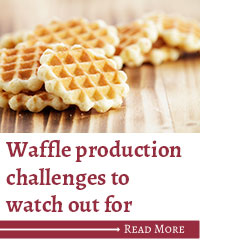Product removal is a critical factor in any waffle or wafer production, but it becomes even more important for specialty formulas and designs that can often be quite delicate.
“For these kinds of products, we offer a vacuum system or needle take-off system that ensures gentle removal from the cavity,” said Patrick Lamprecht, global business development sales, Franz Haas. Additionally, Haas plates are constructed with a special material that prevents sticking; this also helps prevent double deposits caused by failed release.
Tromp Group offers a variety of depanners, including needle, vacuum, continuous, pick-and-place and others, that are designed for specific product types.
“We also aid product release by seasoning our plates in a way that provides a protective layer on the plate,” said Pieter Doornbos, area sales manager and specialists, waffles for Tromp Group.
TSA’s proprietary non-stick, coating-free equipment does not require needles for product removal, but the griddles come with an integrated plate oiling system. For typical waffle and wafer production, bakers usually oil the plates at startup, and it could go for a week without another application. But with some of the more difficult formulas, the baker might have to oil at intervals, such as every few hours, and the TSA oiling system is fully programmable.
 “Once bakers learn their formulas and what they need as far as release oil, they can program it into our machine, and the oiling sequence will be automatic whenever they run the product,” said Mike Niemczyk, sales and business development manager, TSA.
“Once bakers learn their formulas and what they need as far as release oil, they can program it into our machine, and the oiling sequence will be automatic whenever they run the product,” said Mike Niemczyk, sales and business development manager, TSA.
This system also includes a number of brushes.
“The first is an oiling brush, which has a softer bristle to distribute oil over the entire mould surface,” Mr. Niemczyk said. “It gives a good release over the surface of the mould.”
After that, several more aggressive brushes are in use while product is running.
“They’ll remove any little bits and pieces of debris or dried-on batter around the perimeter of the mould while the line is running continuously,” he said.
The final — and most aggressive — set of stainless-steel brushes provide a thorough cleaning at the beginning or end of production, depending on the needs of each specific operation.
Accuracy and efficiency are at the top of the priority list for specialty waffle and wafer products, and minimizing waste is right up there, as well.
In particular, items that require expensive ingredients also require an operation that’s cognizant of waste; one critical area is in depositing the batter.
“A very important variable to consider is the nozzle,” said Lance Aasness, executive vice-president, Hinds-Bock. “It’s one of the smallest parts of the equipment, but it’s probably one of the most important aspects.”
By using nozzles that minimize dripping, such as those with a positive shutoff spout, waste can stay under control. Hinds-Bock’s patented air suck-back technology draws the batter backward after each deposit to avoid spilling or dripping.
When it comes to depositing waffle and wafer batter, nozzle size matters. It all depends on the kind of batter.
“The larger your discharge nozzle, the more likely your depositor is going to drip or dribble a little bit at the end,” said Larry Beck, general manager, TSA Griddle Systems, a division of CPM. “If you have a line that’s never running inclusions, we recommend a slightly smaller nozzle. But if it’s running inclusions regularly, we’ll recommend something bigger to avoid clogging it up.”




